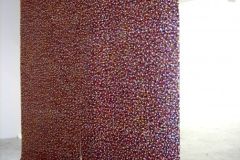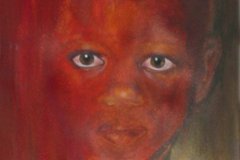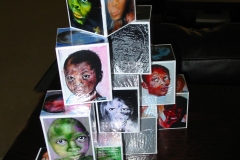Still life in Rwanda Project
Still life in Rwanda is the result of my investigation into genocide and into philosophical discussions surrounding the nature of reality today, where those of us who live in technologically advanced societies are able to observe such atrocities from afar.
I had not particularly wanted to do a piece on genocide. I started this project where I start all my art projects: by looking at order and chaos and how we exist between the two, in a realm scientist call the edge of chaos. This time, I was asking myself: “what happens when we fall off the edge, into the chasm of chaos? Can we ever get back out?”
The answer came during a conversation with my son, Johnny, who had been in Rwanda with Engineers Without Borders installing solar panel systems to remote hospitals and clinics. He returned with stories of people coping, over a dozen years later, with the scars left by genocide.
So here was a situation where man returned from the chasm of chaos.
Genocide is as old as mankind… there is evidence that suggests it was first committed by Cro-Magnon man against the Neanderthal. And it has been with us ever since. But it is this past century that is the bloodiest of them all, with over 50 million people having been systematically murdered because of race, religion or belief. Despite all the ‘never again’ declarations made by world organizations and leaders, genocide continues today.
It was hard enough looking at genocide when I thought I was far removed from it. But the more I investigated, the more I realized perhaps I wasn’t that far removed. Recently, Nobel Peace Prize laureate Elie Wiesel, a Holocaust survivor, said that those who are indifferent are as guilty as the murderers. Certainly, he couldn’t be referring to those of us who only know about such things through the media?
In today’s world we have the ability to instantaneously become aware of what is happening as it happens in other parts of the world. Does this knowledge make us individually more responsible? Has seeing these atrocities as media events, one after another, made us more complacent?
I thought back to where I was 15 years ago. Rwanda’s genocide began in April 1994. It came to me via the news. There were disturbing images and reports of people being hacked to death with machetes. It lasted 100 days. During that time over 800,000 men, women and children were killed.
Still life in Rwanda is an abstract work, comprised solely of 800,000 drops of paint. Both sides are completely saturated with them. It took me over 250 hours to drop them from an eyedropper onto the canvas. There are no overt, anti images in the work, rather the use of scale, colour, light, and presentation are used to create ambiguity: much is left to the viewer.
Still life in Rwanda looks different, depending where you view it. From far back, the different coloured drops look homogeneous. As you get closer, they can be optically dizzying. But if you get right up to the work, and view any part of the canvas very closely, you will see the uniqueness of each drop. Its relationship to other drops becomes apparent. Of the 800,000 drops, no two are alike.



